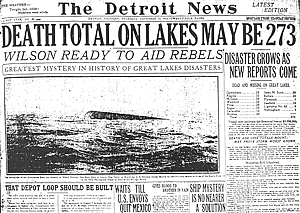The "Great Storms" of 1905 and 1913
Perhaps the Ford’s greatest claim to fame is as a survivor of two horrendous storms that pummeled the Great Lakes region in the first decade of her career. The storms of 1905 and 1913 both claimed many ships and many lives, and unlike the handful of other surviving vessels from that era that were safe in port when these storms struck, the then-Edwin F. Holmes was out in the thick of it both times, and both times she and her crew made it safely to port.
The 1905 "Mataafa Storm"
The 1905 storm is often called the “Mataafa Storm” for the dramatic wreck of the steamer Mataafa just off the harbor entrance in Duluth, Minnesota. The residents of the city could only look on in horror as nine of the Mataafa’s crew perished just beyond the reach of would-be rescuers. Also on Lake Superior, the steamer Lafayette was wrecked at the foot of the bluff that bears her name today, and further up the shore, the landmark Split Rock Lighthouse, opened in 1909, was constructed as a direct result of this storm. In all, 29 vessels were damaged or destroyed in the storm, and 39 people lost their lives.
When the storm struck on November 28, 1905, the Edwin F. Holmes was upbound on Lake Huron with a load of coal for Duluth. After making it safely to the Soo Locks, she ventured out onto storm-tossed Lake Superior. She was reported overdue in Duluth on November 30th, while her identical sistership the Umbria limped into port with her bridge so badly damaged by the storm that she had to be piloted from her emergency steering station aft of the smokestack. The undamaged Holmes finally reached Duluth on December 1, passing the broken wreck of the Mataafa as she entered the harbor.
The 1913 "White Hurricane"
 Detroit News headlines, November 13, 1913. The photo shows the overturned steamer Charles S. Price, one of twelve vessels lost with all hands in the storm.
Detroit News headlines, November 13, 1913. The photo shows the overturned steamer Charles S. Price, one of twelve vessels lost with all hands in the storm.Eight years later, the Holmes was downbound on Lake Superior under the command of Captain C. D. Brown when two powerful storm fronts collided over the Great Lakes. The “Great Storm of 1913” (also described as the “Freshwater Fury” or the “White Hurricane”) is remembered as the worst natural disaster in the recorded history of the Lakes. For five harrowing days between November 6th and November 11th, the massive storm ravaged the region. By the time it subsided, twelve ships had gone down leaving no survivors. Another 32 went aground during the storm, seven of which were completely destroyed. Lake Huron was the hardest hit in terms of ships sunk and lives lost, but major shipwrecks also occurred on Lakes Superior, Erie, and Michigan during the storm. In all, the storm claimed 235 lives on the Lakes, 178 on Lake Huron alone, and about three dozen more ashore.
The Edwin F. Holmes reached the relative safety of Whitefish Bay on the afternoon of November 8th, and dropped anchor to await the re-opening of the Soo Locks which had been closed due to the storm. The crew took the opportunity to adjust the tarps that made the ship’s wooden hatch covers watertight, as they had taken a beating during the trip across the big lake. That evening, conditions eased up, luring a number of unsuspecting vessels out of their safe harbors to continue on their journeys. It was a deceptive lull in the storm, and the worst was yet to come.
The Holmes locked down through the Soo around 4am on the 9th, passed down the St. Mary’s River, and after stopping to replenish her coal bunkers, made her way out into the open waters of Lake Huron. She was one of more than twenty vessels that ventured out into Lake Huron on November 9th. As the day progressed, however, conditions rapidly worsened, and by evening the lake was being swept by sustained hurricane-strength north winds gusting up to 90mph, whipping up 35-foot waves. Caught out in the middle of the lake with nowhere to run for shelter, the Holmes struggled bravely on through the night. During the height of the storm, she encountered a rogue wave that was reportedly over 70 feet high, causing damage to her pilothouse. Another nearby ship sustained serious damage after being struck by a wave that was said to be over 90 feet.
By the afternoon of the 10th, the worst of the storm had passed, revealing its terrible aftermath. The 524-foot steamer Charles S. Price was found floating upside-down off Port Huron, one of eight ships lost with all hands on Lake Huron alone. Another ten were stranded on Lake Huron’s shores and shoals. As those on shore awaited word from the overdue ships, newspaper reports began to reveal the full scope of the tragedy. The Holmes herself was even reported as “wrecked near Goderich” by the Port Huron Times-Herald. However, the early reports were not always accurate. In fact, aside from the pilothouse damage from the encounter with the rogue wave, the Holmes and her crew had made it through the storm unscathed. Of more than twenty ships that ventured out onto Lake Huron on the 9th, the Edwin F. Holmes was one of only a handful that weathered the storm on the open lake and survived.
The Holmes’ first captain, James Owen was less fortunate. He was in command of the Henry B. Smith, which went down in Lake Superior during the height of the storm, taking her entire crew with her.
As the 100th anniversary of the Great Storm of 1913 approaches, we envision a preserved J. B. Ford serving as a lasting memorial to those who lost their lives in that tragic storm.
